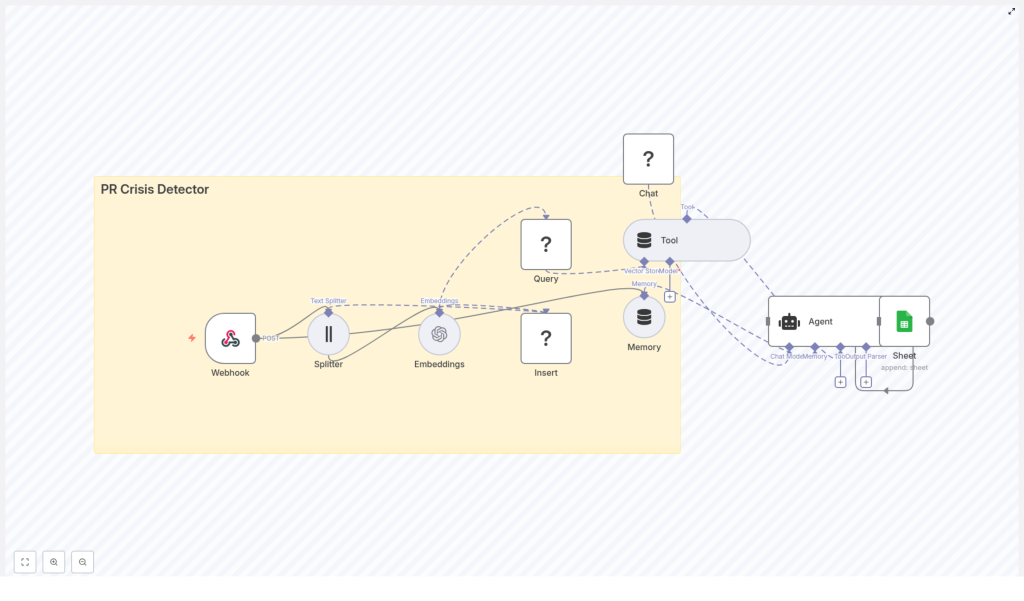Build a Real-Time PR Crisis Detector with n8n and LangChain
Detecting a public relations crisis early can save brand reputation and avoid escalation. This guide walks through a practical PR Crisis Detector workflow built with n8n, LangChain components (embeddings, memory, agent), Redis vector store, and HuggingFace/OpenAI models — all connected to a Google Sheet logger for audit trails.
Why this approach works
This architecture combines:
- Event-driven ingestion via webhooks for real-time monitoring
- Text splitting + embeddings to convert noisy social content into searchable vectors
- Redis as a fast vector store for similarity queries
- An agent and memory for contextual analysis and action suggestions
- A simple Google Sheets logger for reporting and human review
High-level architecture
Core nodes and connections in the workflow:
- Webhook (n8n) — receives POST events (social media, monitoring tool, email-to-webhook)
- Splitter — breaks incoming text into manageable chunks (chunkSize, chunkOverlap)
- Embeddings (OpenAI) — vectorize chunks for semantic search
- Insert (Redis Vector Store) — store embeddings into an index (e.g.,
pr_crisis_detector) - Query (Redis) + Tool — find similar documents and feed them to the agent
- Memory (buffer) — keep recent context for the agent so it retains conversation/state
- Chat (HuggingFace) + Agent — analyze context and generate recommended actions
- Sheet (Google Sheets) — append the agent decision/action to an audit log
Diagram
The provided canvas shows a left-to-right flow: Webhook → Splitter → Embeddings → Insert → Query → Tool → Agent → Sheet. Memory and Chat connect into the Agent to provide context and a language model for reasoning.
Implementation details
1. Webhook: receive events
Configure an n8n Webhook node that accepts POST requests. Typical sources are social monitoring platforms, streaming listeners, or scheduled scrapers.
{
"source": "twitter",
"timestamp": "2025-10-15T12:34:56Z",
"text": "Company X just released a buggy update — total disaster",
"metadata": { "user": "user123", "location": "US" }
}2. Splitter: chunk noisy text
Set the Splitter node to chunkSize=400 and chunkOverlap=40 (adjust based on average message length). This avoids exceeding token limits and keeps context windows meaningful for embeddings.
3. Embeddings and Redis Vector Store
Use OpenAI embeddings or another capable model to generate vectors. Insert them into Redis under a dedicated index like pr_crisis_detector. Keep metadata with each vector (timestamp, source, URL, severity flags).
4. Querying similar signals
When a new event arrives, create an embedding for the event and query Redis for similar vectors. If similarity score or density of similar negative content exceeds a threshold, escalate.
5. Agent + Memory + Chat
Wire a LangChain agent that can:
- Read the top-k similar documents from Redis (Tool)
- Access recent conversation history (Memory)
- Use a language model (HuggingFace or other) to classify severity and propose steps
Prompt engineering is critical. Provide the agent with a clear rubric: what constitutes a minor complaint vs. a crisis, recommended human responses, escalation contacts, and required timing.
6. Google Sheets logger
Append each detection to a Google Sheet with columns: timestamp, source, excerpt, similarity_score, severity, recommended_action, handled_by, notes. This provides a simple audit trail and response tracking for teams that prefer spreadsheets.
Thresholds, scoring, and escalation logic
Example escalation strategy:
- Similarity density: if > 5 similar posts within 10 minutes → mark as “spike”
- Sentiment + keywords: if sentiment is strongly negative and keywords include “lawsuit”, “fraud”, “sue”, or “recall” → escalate to crisis
- Influencer factor: posts from accounts with >100k followers increase score multiplier
These rules can be implemented inside the agent as a rule-engine or as pre-processing logic that annotates the embedding metadata.
Best practices and caveats
Data quality
Garbage in, garbage out. Normalize incoming text, strip noise (HTML, extraneous links), and preserve useful metadata like author, follower_count, and source URL.
Privacy and compliance
Avoid storing PII in the vector store. If you must, encrypt sensitive fields or store only hashed identifiers. Be mindful of platform terms when ingesting user-generated content.
Model selection & cost
OpenAI embeddings and HuggingFace chat models have different costs and latency profiles. Batch embeddings where possible, and monitor usage. Consider open-source embedding models for lower-cost alternatives.
Monitoring & observability
Track these metrics:
- Webhook event rate and error rate
- Embedding latency and costs
- Redis query times and index size
- False positive/negative rates (via human review)
Scaling tips
- Shard or namespace Redis indexes per region/brand when volume grows
- Use rate limiting on inbound webhooks and queueing for downstream processing
- Cache tokenized results and reuse embeddings for repeated identical content
Sample n8n configuration notes
- Splitter: chunkSize=400, chunkOverlap=40
- Embeddings node: model=OpenAI (or alternative)
- Redis Insert/Query: indexName=pr_crisis_detector
- Agent prompt: include severity rubric, action templates, contact list
- Sheet append: documentId=SHEET_ID, sheetName=Log
Next steps and enhancements
Improve detection with:
- Multi-language embeddings to cover global mentions
- Image and video analysis for multimedia posts
- Automated response drafts for review (not auto-posting) to reduce response time
- Integration with Slack, PagerDuty, or incident management tools for faster human intervention
Conclusion
Using n8n and LangChain building blocks — webhook ingestion, text splitting, embeddings, Redis vector store, agent memory, and a chat model — you can create a lightweight but powerful PR Crisis Detector. The system surfaces likely crises, provides contextual analysis and recommended actions, and logs everything for human review.
Ready to deploy this template? Try the workflow in your n8n environment, plug in your API keys, and tune thresholds using real traffic. If you want hands-on help implementing or customizing the detector, get in touch for a consultation or download the template example.
Call to action: Deploy this PR Crisis Detector template today — or contact us for a custom setup and monitoring playbook that fits your brand.

